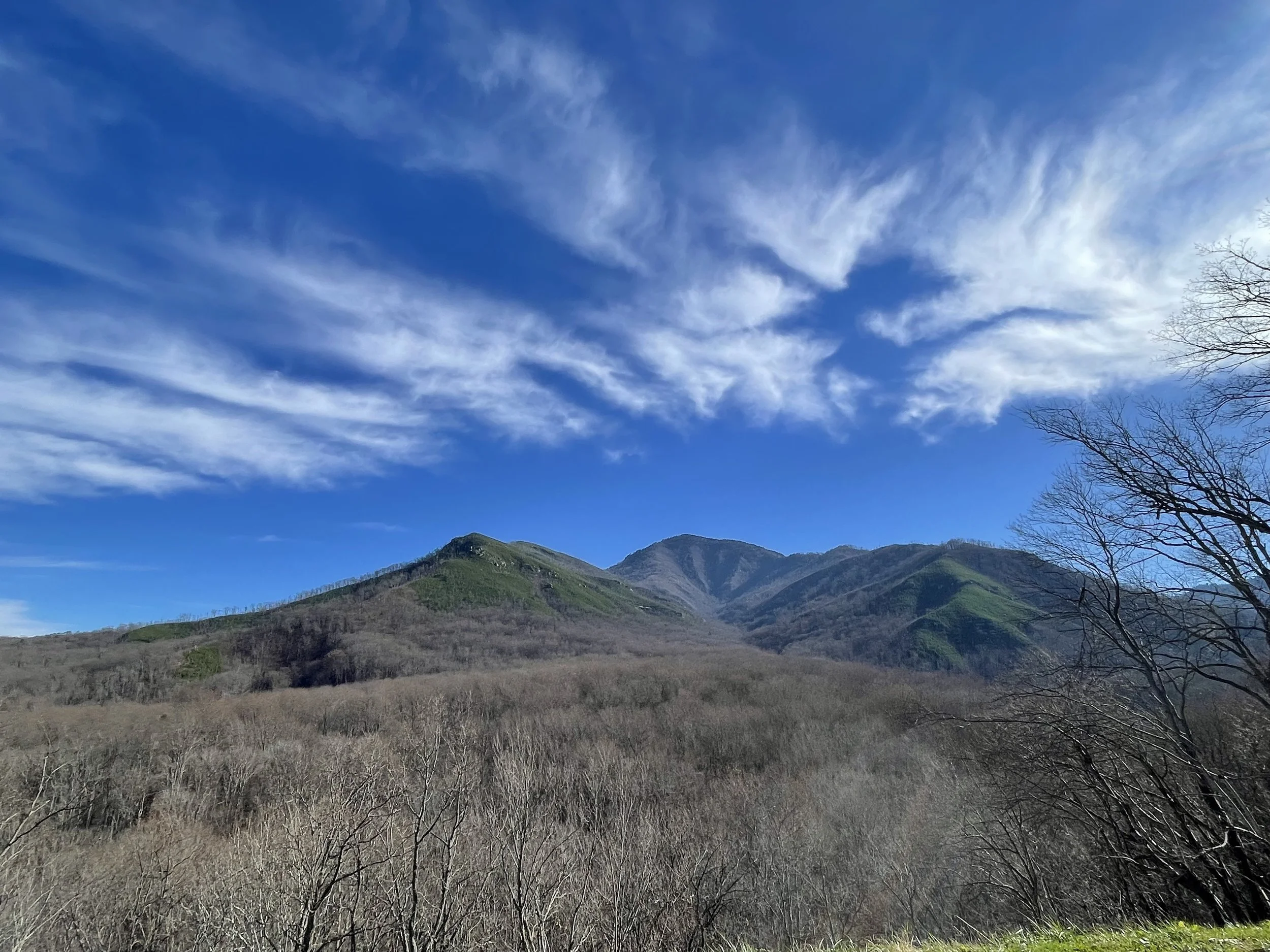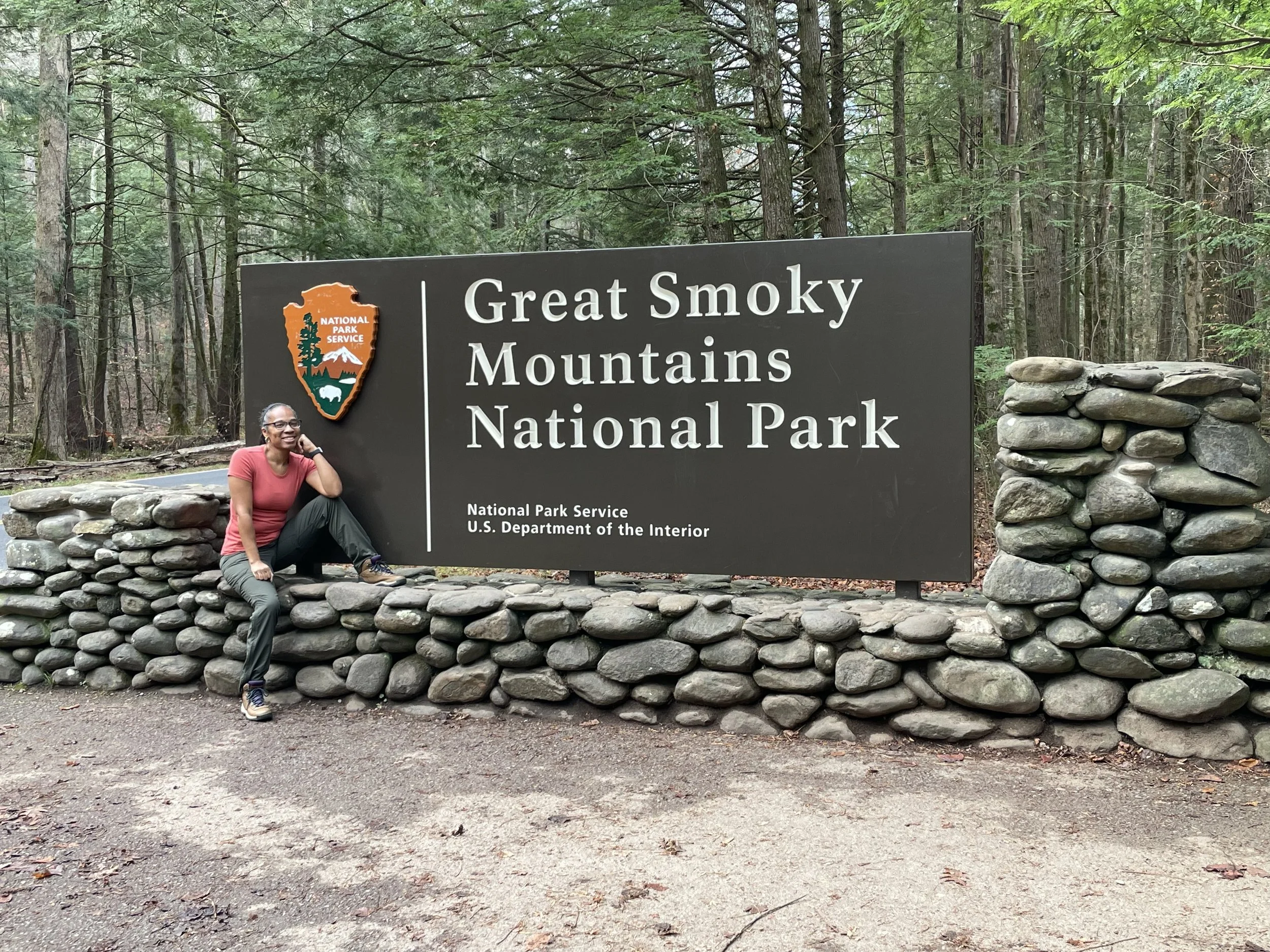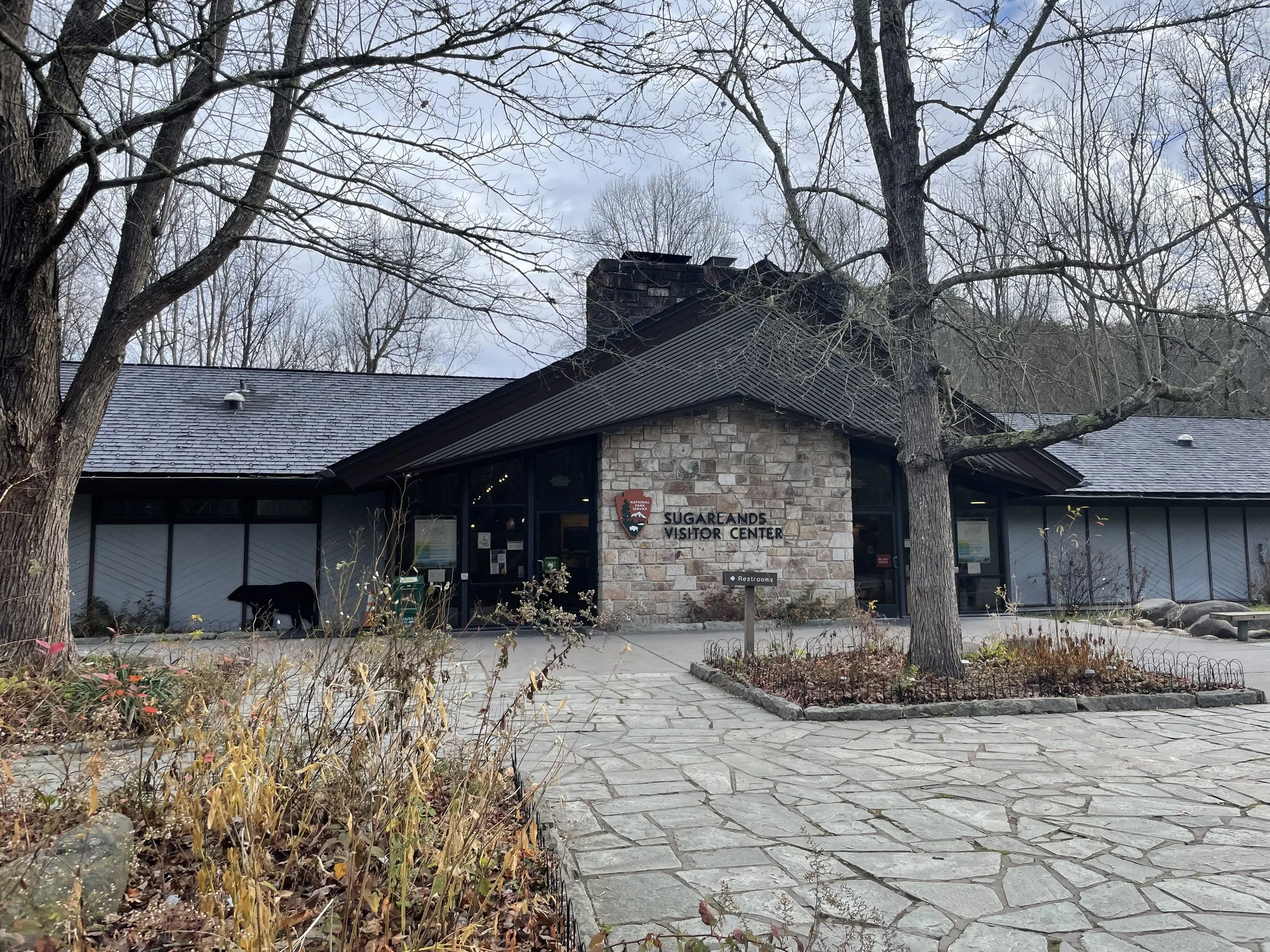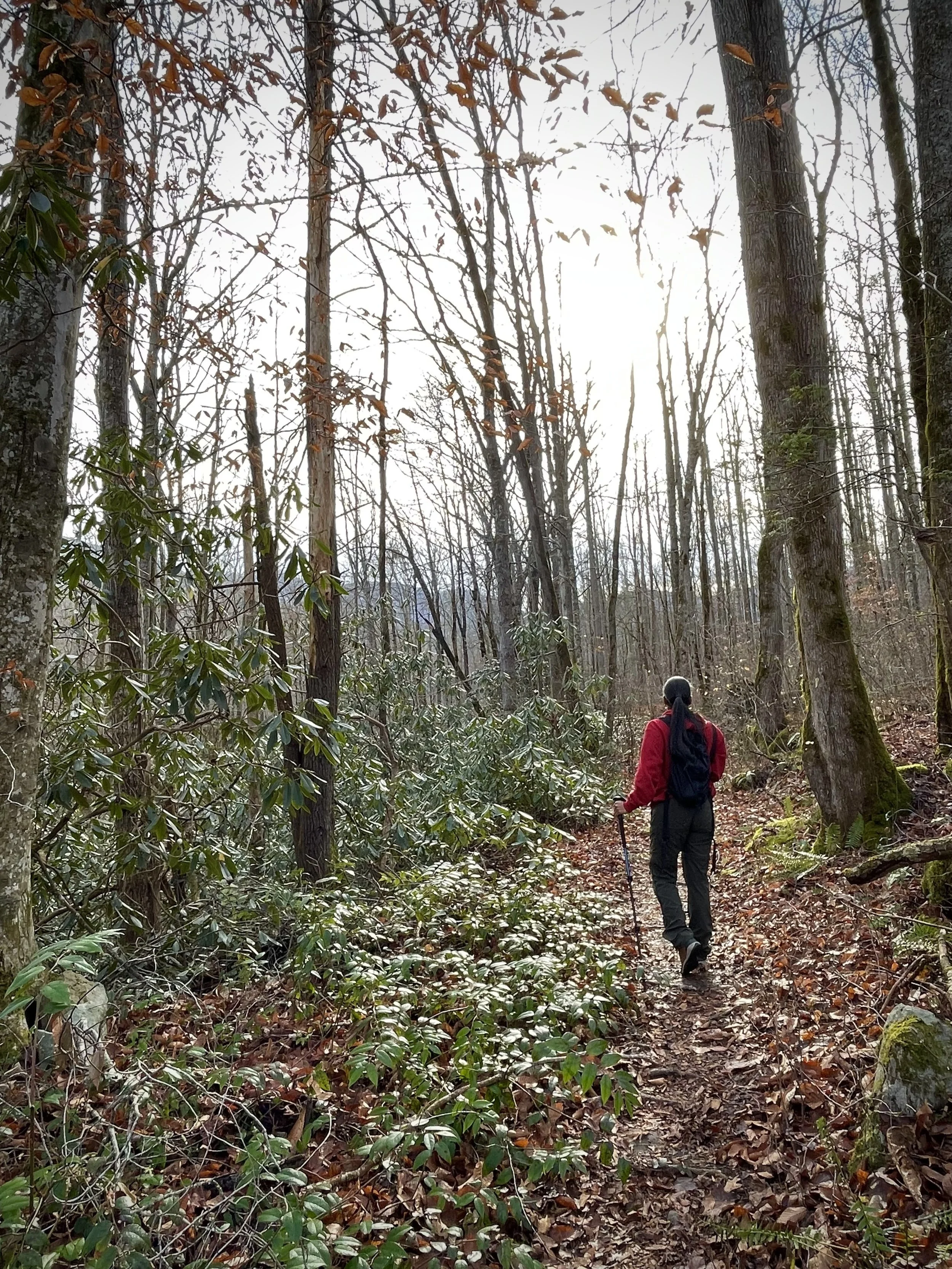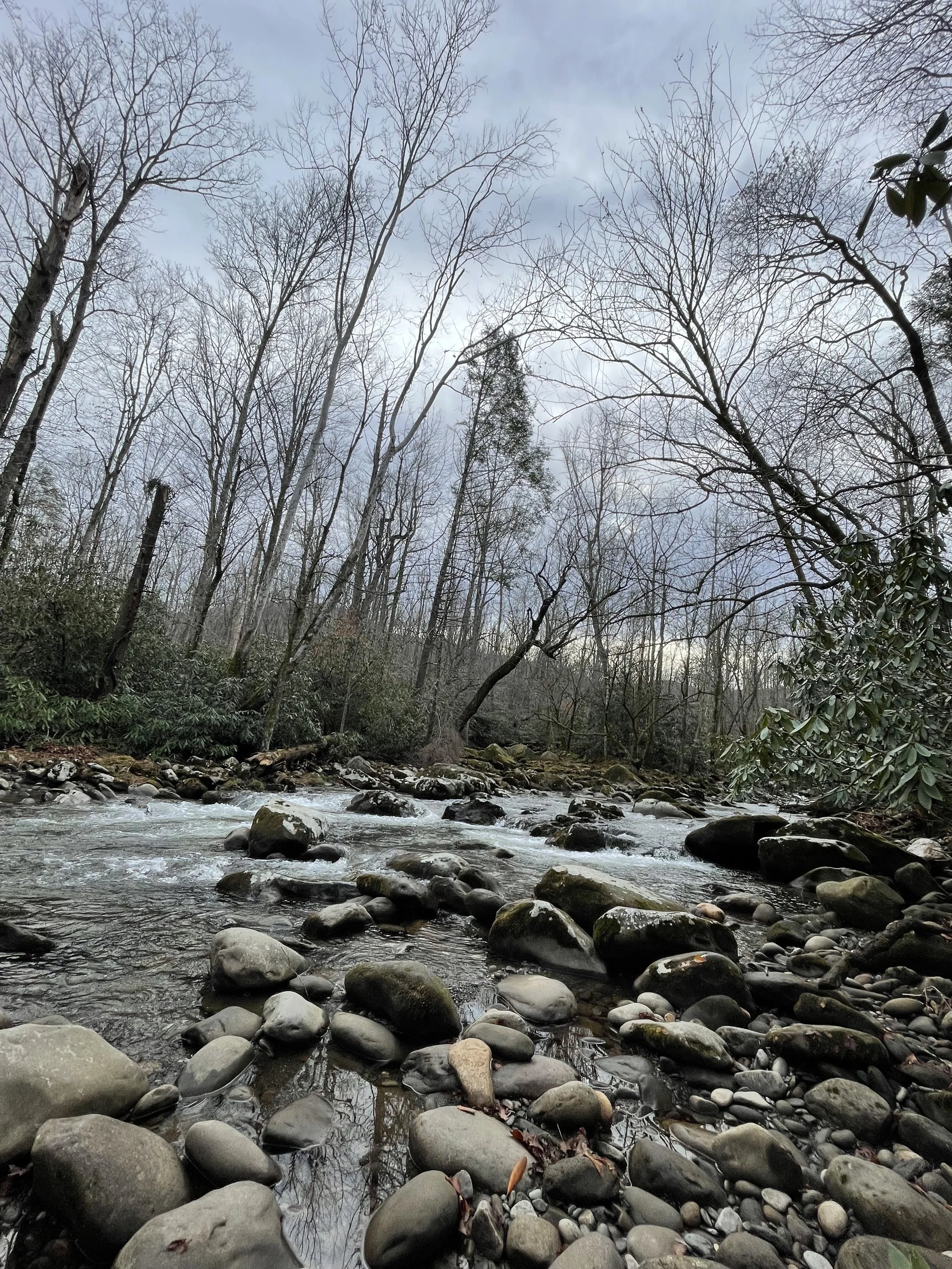#17 Great Smokey Mountains National Park, Tennessee
I’ve visited Great Smoky Mountains National Park twice—once in late spring and again in late fall—and both times, I was struck by the sheer size and breathtaking beauty of the mist-covered peaks, dense forests, and abundant wildlife.
My first visit was during a college trip and my second was a weekend escape from the city, a much-needed retreat into nature. I set out from Chicago on an overcast November morning, eager to trade urban noise for the quiet serenity of the Smokies. However, the trip didn’t go quite as planned—a flat tire just outside of Chicago meant I had to continue the long drive on a spare. The unexpected delay added a few hours to the journey, but it only made the adventure more memorable.
Upon arriving at the park, I stopped at the visitor center, picked up my passport stamp, and asked a ranger for directions to the national park sign—a must-have photo for every visit. With that checked off, I headed back into the park, ready to hit the trails and immerse myself in the wild beauty of the Smokies.
A Bit About The Park
Great Smoky Mountains National Park, straddling the border between North Carolina and Tennessee, is the most visited national parks in the United States. Renowned for its lovely landscapes, the park spans over 500,000 acres of mist-covered peaks, dense hardwood forests, tranquil streams, and wildflower-filled meadows. The Smoky Mountains, named for the ethereal fog that frequently drapes their slopes, are part of the Appalachian Range and serve as a haven for wildlife, including black bears, white-tailed deer, and over 200 species of birds. With more than 19,000 documented species and countless others yet to be discovered, the park is one of the most biologically diverse areas in North America.
The region’s history is deeply rooted in the Cherokee people, who inhabited the land for thousands of years before being forcibly removed during the Trail of Tears in the 1830s. Some Cherokee remained, forming what is now the Eastern Band of Cherokee Indians in North Carolina. By the late 19th and early 20th centuries, extensive logging operations threatened the landscape, leading conservationists and local leaders to campaign for the establishment of a national park. Their efforts, along with funding from John D. Rockefeller Jr. and contributions from Tennessee and North Carolina, culminated in the park’s official designation in 1934.
Today, visitors can explore the park’s natural and cultural wonders through scenic drives and hiking trails. The Cades Cove Loop offers a glimpse into the past with preserved pioneer cabins and churches, along with frequent wildlife sightings. The Roaring Fork Motor Nature Trail provides a scenic journey through lush forests and historic homesteads. Each season transforms the park—spring brings vibrant wildflowers, summer fills the valleys with lush greenery, fall dazzles with fiery foliage, and winter blankets the mountains in a serene layer of snow.
With its rich biodiversity, cultural heritage, and year-round recreational opportunities, Great Smoky Mountains National Park remains a beloved escape for nature lovers, hikers, and history enthusiasts.
Sugarland Visitor Center
Visitor Centers
The park has four main visitor centers, offering information, maps, and exhibits:
1. Sugarlands Visitor Center (Tennessee Side)
Location: Near Gatlinburg, TN (U.S. 441)
Features: Park exhibits, film, ranger programs, bookstore
Nearby Attractions: Cataract Falls, Newfound Gap Road
2. Oconaluftee Visitor Center (North Carolina Side)
Location: Near Cherokee, NC (U.S. 441)
Features: Historical exhibits, Mountain Farm Museum, elk viewing
Nearby Attractions: Mingus Mill, Blue Ridge Parkway
3. Cades Cove Visitor Center
Location: Inside Cades Cove, near Townsend, TN
Features: 19th-century structures, hiking trails
Nearby Attractions: Abrams Falls, scenic loop road
4. Clingmans Dome Visitor Contact Station
Location: At Clingmans Dome parking area (highest point in the park)
Features: Small info center, incredible panoramic views
Nearby Attractions: Clingmans Dome Observation Tower, Appalachian Trail access
Entrances & Fees
Unlike most national parks, Great Smoky Mountains National Park does not charge an entrance fee. However, as of March 2023, a parking tag is required for any vehicle stopping for more than 15 minutes.
Main Entrances:
Gatlinburg, TN (Sugarlands Entrance) – Most popular, leads to Newfound Gap Road
Cherokee, NC (Oconaluftee Entrance) – Great for scenic drives & wildlife
Townsend, TN (Wears Valley Entrance) – Quieter, best for Cades Cove access
Cosby, TN – Lesser-known entrance, great for hiking
Parking Fees:
$5 per day
$15 per week
$40 for an annual pass
Best Hiking Trails
Tennessee Side:
Alum Cave Trail to Mount LeConte (11 miles Round Trip (RT) – Stunning cliffs, one of the best hikes in the park
Andrews Bald (3.6 miles RT) – Panoramic mountain views, accessible from Clingmans Dome
Charlies Bunion (8 miles RT) – Epic views from the Appalachian Trail
Abrams Falls (5 miles RT) – Beautiful waterfall hike in Cades Cove
Laurel Falls (2.6 miles RT) – Easy paved hike to a gorgeous waterfall
North Carolina Side:
Clingmans Dome (1 mile RT) – Short but steep, leading to the highest peak in the Smokies
Deep Creek Loop (5 miles RT) – Great for waterfalls (Tom Branch Falls, Indian Creek Falls)
Kephart Prong Trail (4 miles RT) – Historic CCC structures, peaceful hike
Boogerman Trail (7.4 miles RT) – A quieter hike through an old-growth forest
Top Tourist Attractions
1. Cades Cove (TN)
A scenic 11-mile loop road with historic cabins, churches, and abundant wildlife (bears, deer, turkeys).
2. Clingmans Dome (TN/NC)
The highest point in the park (6,643 feet) with an observation tower providing 360° views.
3. Roaring Fork Motor Nature Trail (TN)
A 5.5-mile scenic drive with old homesteads and waterfall hikes.
4. Blue Ridge Parkway (NC)
Connects to the Oconaluftee Entrance, offering breathtaking overlooks and wildflowers.
5. Newfound Gap Road (TN/NC)
The main road across the park, offering stunning mountain views and access to key sites.
Best Place To Take Photos
Scenic Overlooks & Mountain Views
1. Clingmans Dome – The highest point in the park (6,643 feet) offers unparalleled 360-degree views of the Smoky Mountains. Sunrise and sunset are particularly stunning here.
2. Newfound Gap – A perfect roadside stop with expansive mountain views and a scenic valley backdrop. It’s especially beautiful in fall when the foliage is at its peak.
3. Morton Overlook – A popular sunset spot, with vibrant skies and layers of rolling mountains.
4. Foothills Parkway – A scenic drive with multiple pull-offs offering sweeping views of the Smokies, particularly at sunrise or sunset.
Waterfalls & Streams
5. Laurel Falls – One of the most photographed waterfalls in the park, accessible via an easy paved trail. Best visited early in the morning to avoid crowds.
6. Grotto Falls – A unique waterfall where you can walk behind the cascading water, making for a dramatic and immersive shot.
7. Abrams Falls – Though shorter in height, this waterfall is known for its powerful flow and picturesque settingsurrounded by lush greenery.
8. Ramsey Cascades – The tallest waterfall in the park, reached by a scenic (but challenging) hike, offering spectacular photos of cascading water over rugged rocks.
Historic & Iconic Locations
9. Cades Cove – A photographer’s dream, featuring open meadows, rustic cabins, historic churches, and frequent wildlife sightings (deer, bears, turkeys). Sunrise is the best time for soft lighting and misty fields.
10. Roaring Fork Motor Nature Trail – A beautiful scenic drive with historic homesteads, rushing streams, and old-growth forests. Perfect for moody woodland photography.
11. Elkmont Ghost Town – A fascinating location featuring abandoned cabins and remnants of an old resort community, great for eerie or nostalgic photography.
12. Oconaluftee Valley & Mountain Farm Museum – Located near the North Carolina entrance, this area showcases historic log cabins and barns with mountain backdrops. Elk are often seen grazing in the fields, making for fantastic wildlife shots.
Wildlife Photography Hotspots
13. Cades Cove Loop – The best place in the park to see black bears, deer, and wild turkeys, especially in the early morning or late evening.
14. Cataloochee Valley – A more secluded area known for its large elk herds, particularly during the fall rut season.
Misty & Atmospheric Photography
15. Clingmans Dome Road (at dawn) – The fog often rolls through the valleys at sunrise, creating a mystical layered mountain effect.
16. Anywhere after rainfall – The Smokies get their name from the mist that frequently blankets the mountains. After a rain shower, valleys fill with rising fog, creating dramatic and moody landscapes.

